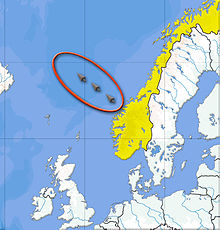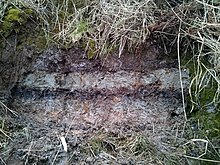Storegga Slide
64°52′N 1°18′E / 64.867°N 1.300°E

The three Storegga Slides are considered to be amongst the largest known landslides. They occurred under water, at the edge of Norway's continental shelf (Storegga is Norwegian for "the Great Edge"), in the Norwegian Sea, 100 km (62 mi) north-west of the Møre coast, causing a very large tsunami in the North Atlantic Ocean. This collapse involved an estimated 290 km (180 mi) length of coastal shelf, with a total volume of 3,500 km3 (840 cu mi) of debris.[1] This would be the equivalent volume to an area the size of Iceland covered to a depth of 34 m (112 ft).
Based on carbon dating of plant material recovered from sediment deposited by the tsunami, the latest incident occurred around 6100 BCE.[2] In Scotland, traces of the subsequent tsunami have been recorded, with deposited sediment being discovered in Montrose Basin, the Firth of Forth, up to 80 km (50 mi) inland and 4 m (13 ft) above current normal tide levels.
As part of the activities to prepare the Ormen Lange natural gas field, the incident has been thoroughly investigated. One conclusion is that the slide was caused by material built up during the previous ice age, and that a recurrence would only be possible after a new ice age.[1] Facts and arguments supporting this conclusion were made public in 2004. Earlier it was concluded that the development of the Ormen Lange gas field would not significantly increase the risk of triggering a new slide. A new slide would trigger a very large tsunami that would be devastating for the coast areas around the North Sea and the Norwegian Sea.


Possible mechanism
Earthquakes, together with gases (e.g. methane) released from the decomposition of gas hydrates, are considered to be the likely triggering mechanisms for the slides. Another possibility is that the sediments became unstable and failed perhaps under the influence of an earthquake or ocean currents.[1]
Impact on human populations
At, or shortly before, the time of the last Storegga Slide, a land bridge known to archaeologists and geologists as "Doggerland" existed, linking Great Britain with Denmark and the Netherlands across what is now the southern North Sea. This area is believed to have included a coastline of lagoons, marshes, mudflats, and beaches, and to have been a rich hunting, fowling and fishing ground populated by Mesolithic human cultures.[4][5][6] Although Doggerland was physically submerged through a gradual rise in sea level, it has been suggested that coastal areas of both Britain and mainland Europe, extending over areas which are now submerged, would have been inundated by a tsunami triggered by the Storegga Slide. This event would have had a catastrophic impact on the contemporary Mesolithic population, and separated cultures in Britain from those on the European mainland.[7]
See also
External links
References
- ^ a b c Bondevik, Stein (2003). "Record-breaking Height for 8000-Year-Old Tsunami in the North Atlantic" (PDF). EOS, Transactions of the American Geophysical Union. 84 (31): 289, 293. Bibcode:2003EOSTr..84..289B. doi:10.1029/2003EO310001. Retrieved 2007-01-15.
{{cite journal}}: Unknown parameter|coauthors=ignored (|author=suggested) (help); Unknown parameter|month=ignored (help) - ^ Bondevik, S; Lovholt, F; Harbitz, C; Stormo, S; Skjerdal, G (2006). "The Storegga Slide Tsunami - Deposits, Run-up Heights and Radiocarbon Dating of the 8000-Year-Old Tsunami in the North Atlantic". American Geophysical Union meeting.
{{cite conference}}: Unknown parameter|booktitle=ignored (|book-title=suggested) (help)CS1 maint: multiple names: authors list (link) - ^ http://mail.hsebooks.com/research/othpdf/200-399/oth323.pdf
- ^ "Doggerland Project", University of Exeter Department of Archaeology
- ^ Vincent Gaffney, "Global Warming and the Lost European Country"
- ^ "Britain's Drowned World", Time Team, Channel 4 Television, 24 April 2007
- ^ Bernhard Weninger et al., The catastrophic final flooding of Doggerland by the Storegga Slide tsunami, Documenta Praehistorica XXXV, 2008
